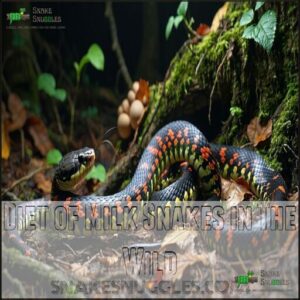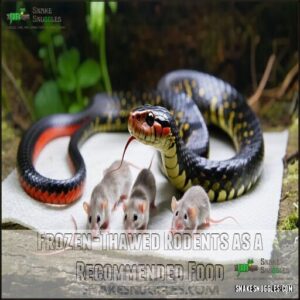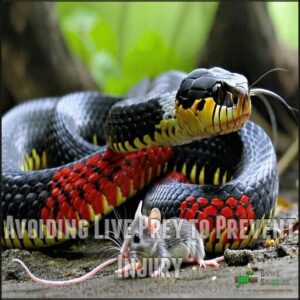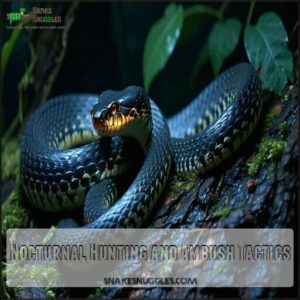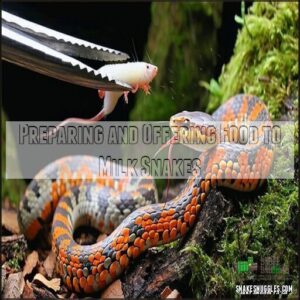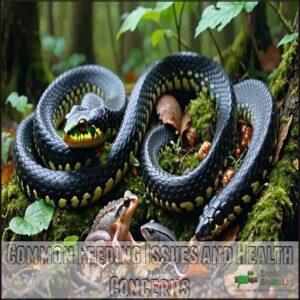This site is supported by our readers. We may earn a commission, at no cost to you, if you purchase through links.

They’re also fond of birds, eggs, lizards, and even other snakes! These colorful constrictors have quite the appetite for a snake their size.
In captivity, you’ll want to feed them appropriately sized frozen-thawed mice or rats, avoiding live prey that might injure your pet.
Young milk snakes typically eat pinky mice, while adults graduate to adult mice or small rats.
Their hunting technique involves constriction – they’ll squeeze their prey before consuming it whole.
Proper feeding techniques can make all the difference between a thriving snake and feeding struggles.
Table Of Contents
- Key Takeaways
- Diet of Milk Snakes in The Wild
- What Do Milk Snakes Eat in Captivity
- Types of Prey for Milk Snakes
- Feeding Habits and Hunting Techniques
- Nutritional Requirements for Milk Snakes
- Preparing and Offering Food to Milk Snakes
- Common Feeding Issues and Health Concerns
- Frequently Asked Questions (FAQs)
- What do milk snakes eat?
- How to make a milk snake hunt for its food?
- Do milk snakes need a balanced diet?
- Do milk snakes eat lizards?
- What can I feed my milk snake?
- Will a milk snake bite you?
- Will a milk snake eat crickets?
- Are milk snakes good pets?
- How poisonous is a milk snake?
- How often should a milk snake be fed?
- Conclusion
Key Takeaways
- You’ll find milk snakes primarily eat small rodents like mice and voles in the wild, but they also consume birds, lizards, eggs, and even other snakes as opportunistic carnivores.
- When feeding your captive milk snake, you should offer appropriately sized frozen-thawed mice or rats (never live prey) on a schedule that varies with age—weekly for juveniles and every 7-10 days for adults.
- Your milk snake captures prey through constriction, utilizing their remarkable sense of smell and nocturnal hunting abilities to track and subdue victims before consuming them whole.
- You’ll need to watch for common feeding issues like refusal to eat, regurgitation, and obesity, while maintaining proper feeding techniques with feeding tongs in a designated area to prevent your snake from associating your hands with food.
Diet of Milk Snakes in The Wild
You’ll find that milk snakes in the wild are opportunistic carnivores that hunt a variety of prey including rodents, birds, lizards, other snakes, and even eggs.
These nocturnal hunters use their excellent sense of smell and constriction abilities to track and subdue prey that can be up to 1.5 times their own body width.
Terrestrial Vertebrates as Primary Prey
In nearly all natural habitats, terrestrial vertebrates form the cornerstone of the milk snake diet. These adaptable reptiles have evolved specialized hunting strategies that make them efficient predators of ground-dwelling creatures.
When seeking prey, milk snakes rely on their remarkable sensory adaptations. They detect subtle ground vibrations from potential meals, while their forked tongue collects scent particles that help them track prey diversity across seasonal variations in their environment.
- Their ability to silently glide through leaf litter makes them the unseen nightmares of small wild vertebrates
- The precision with which they strike leaves prey with virtually no chance of escape
- Their patient hunting approach can involve following a scent trail for hours before attacking
Unlike many predators, milk snakes exhibit impressive flexibility, allowing them to pursue food sources into tight spaces where other hunters can’t follow.
Small Mammals and Birds as Food Sources
Milk snakes prowl through wilderness areas with a specialized appetite for warm-blooded prey.
Your captive milk snake’s diet mirrors what these efficient hunters target in nature: primarily small mammals and birds.
Rodent nutrition forms the cornerstone of their wild diet, with mice delivering essential proteins and fats needed for healthy growth.
When considering milk snake food options, understand their natural preferences:
- Field mice constitute approximately 60% of a wild milk snake’s diet, providing ideal rodent nutrition
- Voles and shrews serve as perfect bite-sized meals for younger snakes seeking smaller prey
- Young rats become targeted prey items, especially in edge habitats where forest meets field
- Ground-nesting birds occasionally supplement their diet, adding prey variety
- Bird eggs represent seasonal delicacies, offering concentrated nutrition during spring breeding seasons
This prey variety guarantees milk snakes receive complete nutrition while satisfying their natural hunting instincts.
Reptiles, Amphibians, and Insects in The Diet
While rodents form the cornerstone of a milk snake’s diet, these adaptable hunters don’t stop there.
Your milk snake also actively hunts other reptiles, with lizard consumption being particularly common. Slender skinks and small garter snakes often fall prey to their constricting grasp.
Frog intake increases during wet seasons, when amphibians become more accessible. For juvenile milk snakes, insects play a vital developmental role—crickets, slugs, and earthworms provide essential nutrition for growing snakes.
Milk snakes possess smooth and shiny scales, which helps them navigate diverse habitats. This dietary variation guarantees milk snakes thrive across diverse habitats, adapting their hunting strategies to whatever prey is available.
What Do Milk Snakes Eat in Captivity
Most captive milk snakes thrive on a consistent diet of frozen-thawed rodents, unlike their diverse wild menu. Your scaled companion needs specific feeding schedules based on age and size.
- Juvenile snakes require weekly meals to support rapid growth phases
- Adult milk snakes typically eat every 7-10 days, mimicking natural feeding patterns
- Proper supplementation with calcium and vitamin D3 prevents common health issues
When preparing your snake’s captive diet, always thaw rodents completely and use handling techniques that don’t associate your hands with food. Gut loading prey can substantially boost nutrient content. Watch for signs of healthy eating: regular shedding, steady growth, and active behavior between meals, which are indicators of a well-planned diet with the right supplementation and feeding schedules. A consistent diet and proper care can lead to a thriving pet.
Types of Prey for Milk Snakes
You’ll find that milk snakes consume a surprisingly diverse menu of prey items in both wild and captive environments.
Their diet primarily consists of rodents, birds, lizards, other snakes, and even amphibians, with their specific preferences adapting based on age, size, and habitat availability.
Frozen-Thawed Rodents as a Recommended Food
When keeping milk snakes as pets, frozen-thawed rodents stand out as the gold standard for feeding.
These pre-killed meals offer complete nutritional value while eliminating risks associated with live prey.
For proper storage guidelines, keep rodents frozen until needed. Thawing methods matter – warm to room temperature in sealed bags to prevent bacterial contamination.
Safe handling includes using tongs for offering food, which prevents accidental bites. Many owners source their frozen snake food online.
Most milk snake prey choices come down to mice of various sizes, which perfectly match their natural diet without endangering your scaly friend.
Appropriately Sized Prey for Different Age Groups
Finding the perfect prey size for your milk snake is essential for proper growth and digestion at every life stage.
When feeding milk snakes of different ages, follow these guidelines:
- Hatchlings (0-3 months): Offer pinkie mice weekly – they should be no larger than the widest part of your snake’s body
- Juveniles (3-12 months): Graduate to fuzzy mice every 5-7 days as your snake grows
- Subadults (1-2 years): Hopper mice or small adult mice every 7-10 days work well
- Adults (2+ years): Adult mice once every 7-14 days, maintaining the 1.5x body width rule
Remember, proper prey thickness prevents regurgitation and digestive issues. Their diet should also maintain whole animal prey for ideal nutrition. Your milk snake’s diet should evolve with its growth stages, ensuring superior nutrition throughout its life, and always consider the importance of digestive issues.
Avoiding Live Prey to Prevent Injury
While appropriately sizing prey matters, protecting your milk snake from harm during mealtime is equally important.
Feeding live prey to your milk snake isn’t recommended – those mice and rats will fight for their lives, potentially causing serious injuries to your pet.
Switch to frozen-thawed mice instead, offering the same nutrition without the risks. This humane feeding approach also prevents scratches and bites but makes ethical sense as well.
Always use feeding tongs to present meals, keeping your fingers safe and your snake’s feeding routine stress-free.
Feeding Habits and Hunting Techniques
You’ll find milk snakes are skilled nocturnal hunters that rely on their exceptional sense of smell and ground vibrations to track prey.
They’re patient constrictors that wrap their bodies around victims like mice, birds, and even other snakes, gradually tightening until the prey can no longer breathe, which showcases their exceptional hunting strategy.
Nocturnal Hunting and Ambush Tactics
The elusive milk snake transforms into a master hunter as darkness falls.
Unlike daytime predators, these nocturnal specialists use sophisticated hunting techniques:
- Their heat-sensing organs detect warm-blooded prey through complete darkness
- Scent tracking abilities follow rodent trails across complex environments
- Strike speed reaches lightning-fast velocities, giving prey no escape chance
- Sensory adaptations allow them to "see" their environment without light
They don’t merely ambush—they strategically stalk, creating the perfect moment to attack, utilizing their ability to detect warm-blooded prey and move with lightning-fast velocities.
Use of Constriction to Subdue Prey
While milk snakes hunt under the cover of darkness, their true expertise lies in their constriction technique. These remarkable constrictors coil their muscular bodies around prey with impressive precision.
Milk snakes transform hunting into deadly art, silently wrapping their victims in a precise, inescapable embrace that tightens with every breath.
- Their constriction strength increases with each exhale of their prey, gradually restricting breathing
- They can successfully overpower prey up to 1.5 times their body width, showcasing their hunting efficiency
- This evolutionary advantage requires minimal energy while ensuring maximum success rate
You’ll be amazed how these specialized hunters use muscular adaptations to subdue prey through suffocation rather than crushing.
Importance of a Strong Sense of Smell
Invariably, milk snakes rely on their remarkable sense of smell as their primary hunting tool.
Their forked tongue flicks constantly, collecting scent particles that transfer to their Jacobson’s organ—a specialized sensory structure that processes these chemical signals with extraordinary precision.
When hunting in complete darkness, these serpents follow scent trails with laser-like focus, detecting even the faintest rodent musk.
This nocturnal olfaction works alongside their ability to sense ground vibrations, creating a multi-sensory prey detection system.
Milk snakes also utilize seismic signal detection to locate potential meals.
You’ll never see a milk snake hunting without this olfactory GPS guiding their every move.
Nutritional Requirements for Milk Snakes
You’ll need to provide your milk snake with a balanced diet rich in proteins and fats from appropriately sized rodents to support their growth and overall health.
Their nutritional needs include essential vitamins and minerals that come naturally from whole prey items, making a varied diet of properly sized mice or rats the foundation of proper snake nutrition.
Balanced Diet of Proteins, Fats, and Carbohydrates
While maintaining a balanced milk snake diet relies heavily on understanding proper macronutrient proportions, proteins take center stage at 30-60% of their nutritional needs.
These carnivores thrive on protein sources like rodents, which support muscle development and growth. Fat importance can’t be overstated, as it comprises 25-60% of their diet, providing essential energy for these reptiles.
Carb inclusion is minimal, with negligible fiber content—exactly what these specialized predators need. Dietary ratios shift during brumation needs, when metabolism slows.
Whole animal prey delivers the perfect snake diet facts: high protein, adequate fat, and minimal carbohydrates. Your snake’s nutritional balance directly impacts their health and longevity.
Essential Vitamins and Minerals for Health
Beyond proteins and fats, your milk snake needs specific vitamins and minerals for peak health.
Calcium serves as the cornerstone of your snake’s skeletal system, while Vitamin D3 helps absorb this essential mineral.
Milk snakes are known to have generally good temperaments making them easier to handle during feeding.
During brumation, these needs change slightly but remain important.
- Calcium sources protect against metabolic bone disease
- Proper mineral balance prevents neurological issues
- Supplement schedule: dust prey items 1-2 times weekly
- Reptile nutrition experts recommend Repashy Calcium Plus LoD
- Vitamin requirements increase during growth and breeding periods
Individual Dietary Needs and Veterinary Check-Ups
Despite their generally straightforward dietary needs, milk snakes occasionally require personalized nutrition plans. Your snake’s specific requirements may vary based on age, size, and health status.
Regular veterinary check-ups are essential for health monitoring, especially if you notice changes in feeding habits. A reptile nutrition specialist can evaluate whether your milk snake needs dietary adjustments during different life stages or brumation periods.
Some snakes benefit from careful supplement schedules, particularly calcium for growing juveniles. Age-based diets guarantee proper development—hatchlings need different feeding frequencies than adults.
Don’t experiment with your snake’s balanced diet without professional guidance. When in doubt, consult a veterinary nutritionist familiar with milk snake diet requirements.
Preparing and Offering Food to Milk Snakes
You’ll need to properly prepare frozen prey items by thawing them completely in a sealed bag before offering them to your milk snake.
Always use feeding tongs to present the food, keeping your fingers safely away from your snake’s striking range during mealtime.
Thawing and Warming Frozen Prey Items
Properly thawing frozen rodents guarantees your milk snake receives safe, nutritious meals. After guaranteeing proper nutrition for your snake, handling frozen prey correctly becomes your next priority.
Follow these three steps for safe thawing:
- Place frozen-thawed mice in a sealed plastic bag in the refrigerator for 8-12 hours to prevent bacterial growth
- Warm the thawed rodent to room temperature using warm (not hot) water for 15-20 minutes
- Dry the prey thoroughly with paper towels before offering to your snake
This careful temperature control preserves nutritional value while minimizing harmful bacteria that could make your pet sick. Consider products for thawing to streamline the process and ensure your snake’s health.
Using Feeding Tongs for Safe Food Presentation
Feeding tongs are your milk snake’s dinnertime lifesavers, creating essential distance between your fingers and their feeding response.
When offering frozen-thawed mice, select tongs based on your comfort and snake’s size – metal options provide durability while silicone-tipped versions offer gentler grip. Keep your tongs at least 12 inches long to maintain safe distance from striking snakes.
Always clean tongs thoroughly after use to prevent bacteria spread and cross-contamination. Mimicking prey items slightly mimics natural movement, triggering your snake’s hunting instinct while minimizing stress.
Remember, consistent tongs use prevents your hand from becoming associated with food. Using tongs also helps to minimize risk of bites and is a crucial part of safe feeding practices, ensuring a stress-free environment for your snake, and promoting healthy feeding habits with gentle grip options.
Creating a Designated Feeding Area
While using feeding tongs keeps your hands safe, creating a designated feeding area takes your milk snake’s mealtime to the next level.
Set up a simple plastic container separate from the main enclosure—this dedicated space helps with monitoring consumption and prevents substrate ingestion. Your milk snake diet routine becomes more hygienic when prey items don’t leave residue in the main habitat.
This approach offers excellent stress reduction since your snake won’t associate your hand entering their home with feeding time. Many experienced keepers find this injury prevention strategy particularly valuable with growing collections.
The feeding station doesn’t need to be fancy—just clean, appropriately sized, and consistently used for snake food presentation. Consider a specialized feeding container for this purpose.
Common Feeding Issues and Health Concerns
You’ll need to watch for feeding issues that can affect your milk snake’s health, including refusal to eat, regurgitation, and potential obesity from overfeeding.
A proper feeding routine and appropriate diet are essential for preventing these problems and ensuring your snake maintains peak health throughout its life.
Refusal to Eat and Regurgitation in Captive Snakes
Facing a meal rejection, your milk snake may be experiencing stress-induced anorexia or digestive issues that warrant attention.
- Temperature issues often trigger regurgitation—ensure proper heat gradients for digestion
- Improper handling after feeding disrupts the digestive process, causing regurgitation
- Parasitic infections can suppress feeding response, requiring veterinary intervention
- Metabolic disorders may manifest as persistent food refusal
When your captive snake’s diet becomes problematic, monitor closely for weight loss and lethargy. Don’t wait six weeks before seeking help—prolonged refusal to eat signals potential health concerns requiring immediate action.
Overfeeding and Obesity in Milk Snakes
Overfeeding transforms your milk snake from sleek predator to sluggish captive.
Weight gain appears gradually—watch for skin folds, decreased activity, and difficulty moving.
Obesity leads to serious health risks including fatty liver disease and shortened lifespan.
Prevention strategies include:
- Stick to age-appropriate feeding schedules (once weekly for adults)
- Offer appropriately-sized prey (no wider than the snake’s widest point)
- Monitor body condition regularly
- Provide adequate enclosure space for exercise
Many owners mistakenly equate feeding with affection.
Remember that proper weight management through careful dietary adjustments guarantees your milk snake will enjoy a healthy, active life.
This understanding is crucial for the well-being of your pet.
Importance of Proper Diet for Long-Term Health
When you prioritize superior nutrition for your milk snake diet, you’re investing in your pet’s longevity.
Balanced feeding schedules support healthy organ function and proper growth rates throughout their lives.
During brumation, adjust portions accordingly while maintaining dietary variety year-round.
Monitor your pet regularly for signs of nutritional deficiencies, which might indicate supplement needs, to ensure a well-fed milk snake.
Remember, a happy snake isn’t just a happy snake—it’s one that will thrive for years to come.
Frequently Asked Questions (FAQs)
What do milk snakes eat?
Ever wondered about a milk snake’s menu?
Your milk snake will primarily eat mice, rats, and other small rodents.
They’ll also consume birds, lizards, frogs, and even other snakes in the wild.
How to make a milk snake hunt for its food?
You should stimulate a milk snake’s hunting instincts by moving prey with feeding tongs, mimicking natural movement.
Don’t use live prey as it can injure your snake.
Always feed in a separate container, and remember to mimicking natural movement is key when using feeding tongs.
Do milk snakes need a balanced diet?
Yes, your milk snake needs a balanced diet.
80% of their nutritional intake comes from rodents.
You’ll want to provide appropriately sized frozen-thawed mice weekly, which contain all essential proteins and fats they require.
Do milk snakes eat lizards?
Milk snakes do consume lizards as part of their natural diet.
You’ll find they’re particularly common prey for juveniles, though adults will happily eat them too when available.
They’re skilled hunters of various reptiles.
What can I feed my milk snake?
Over 90% of captive milk snakes thrive on frozen-thawed mice.
You can feed your snake appropriately sized rodents once weekly for adults and every 5-7 days for juveniles.
Always use feeding tongs for safety.
Will a milk snake bite you?
Although milk snakes can bite if threatened or startled, they’re generally docile creatures.
You’ll rarely experience bites if you handle them gently, avoid feeding-time interactions, and respect their personal space during shedding periods, which helps maintain their natural behavior and reduces the likelihood of bites.
Will a milk snake eat crickets?
Like a hourglass measuring time, crickets represent merely a stepping stone in a milk snake’s diet. You’ll find they’re only suitable for hatchlings, while adults need rodents for proper nutrition.
Are milk snakes good pets?
Milk snakes make excellent pets due to their docile nature, manageable size, and relatively easy care requirements.
They’re non-venomous, don’t need large enclosures, and you’ll find their vibrant patterns visually appealing.
How poisonous is a milk snake?
As harmless as a feather falling from the sky, milk snakes aren’t poisonous at all. They’re actually non-venomous constrictors that mimic coral snakes’ appearance but pose zero threat to you.
How often should a milk snake be fed?
You’ll need to feed your milk snake every 5-7 days as a juvenile, and once every 7-10 days as an adult.
Adjust based on your snake’s size, appetite, and how well it’s digesting, which are key factors in determining the feeding schedule.
Conclusion
Whether milk snakes eat rodents, birds, or other reptiles, providing proper nutrition guarantees your pet thrives for years.
You’ll find that understanding what milk snakes eat helps prevent common feeding issues like refusal or regurgitation.
Remember to match prey size to your snake’s age—pinkies for juveniles, adult mice for mature specimens.
By following these dietary guidelines and feeding techniques, you’ll maintain a healthy, vibrant milk snake that efficiently displays its natural hunting behaviors.
- https://animaldiversity.org/accounts/Lampropeltis_triangulum/
- https://www.snakesociety.nl/jaargangen/1992e/Litteratura%20Serpentium%2012-5%20095-097%20vdEerden,%20Keeping%20and%20breeding%20Lampropeltis%20triangulum%20campbelli.pdf
- https://talis-us.com/blogs/news/milk-snakes-understanding-their-diet?srsltid=AfmBOoocEEgRVUNsK_6pDnwi7QPWGiAwpCDCra7F1fqfts-EEPqGdlUT
- https://animalia.bio/milk-snake
- https://en.wikipedia.org/wiki/Milk_snake

